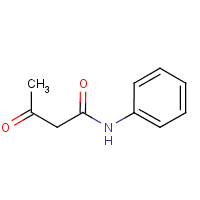Acetoacetanilide
Agent Name
Acetoacetanilide
CAS Number
102-01-2
Formula
C10-H11-N-O2
Major Category
Nitrogen Compounds

Synonyms
((Acetoacetyl)amino)benzene; 1-(Phenylcarbamoyl)-2-propanone; 3-Oxo-N-phenylbutanamide; Acetanilide, 2-acetyl-; Acetoacetamidobenzene; Acetoacetanilid; Acetoacetanilide; Acetoacetic acid anilide; Acetoacetic anilide; Acetoacetylaniline; Anilid kyseliny acetoctove; Anilid kyseliny acetoctove [Czech]; Butanamide, 3-oxo-N-phenyl-; Butanoic acid, 3-oxo-, amide, N-phenyl-; N-(Acetylacetyl)aniline; N-Phenylacetoacetamide; alpha-Acetyl-N-phenylacetamide; beta-Ketobutyranilide; [ChemIDplus] AAA; [Reference #1]
Category
Other Aromatics (Nitrogen)
Description
White solid; [Hawley] White, odorless crystalline powder; [Alfa Aesar MSDS]
Sources/Uses
Used in rubber compounding and in manufacturing other chemicals (hansa yellow dyes, benzidine yellow pigments, the fungicides carboxin and methfuroxam, and pyrazolones and pyrimidines); [HSDB]
Comments
Reports of reversible eye burns in humans; Not irritating to skin and mildly irritating to eyes of rabbits; No evidence of skin sensitization in guinea pigs; Causes slight methemoglobinemia and significant formation of Heinz bodies in cats following single oral administration of 100 mg/kg; Hemolytic anemia and corresponding injury to liver, spleen, and kidneys observed in 28-day oral study of rats (850 mg/kg/day and, to some extent, at 100 mg/kg/day); Emergency treatment: "Phenacetin"; Phenacetin was used as a pain-relieving drug, but has not been available in the US since 1983. Can cause methemoglobinemia after ingestion >1 gram/day; Can cause renal papillary necrosis following ingestion of large doses for years; [HSDB] A weak allergen; [CAMEO] A mild skin irritant; Can be absorbed through skin; [Alfa Aesar MSDS]
Biomedical References
Exposure Assessment
Vapor Pressure
0.01 mm Hg
Explanatory Notes
Flash point = 162.7 deg C; [Hawley]
NFPA
must be preheated
Adverse Effects
Methemoglobinemia
MetHgb is secondary toxic effect
Hepatotoxin
Hepatoxic (a) from occupational exposure (secondary effect) or (b) in animal studies or in humans after ingestion
Nephrotoxin
Yes
Diseases, Processes, and Activities Linked to This Agent
Other Information
No other related information on this agent was found.